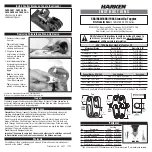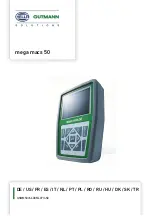
Installation and Operational Instructions
for ROBATIC
®
-clutch Type 500.30_.0
Sizes 3 – 7 (double-flow)
(B.5.5.GB)
27/11/2008 TK/EI/SU
Chr. Mayr GmbH + Co. KG
Tel.: 08341 / 804-241
Eichenstraße 1
Fax: 08341 / 804-422
87665 Mauerstetten
http://www.mayr.de
Page 7 of 8
Germany
eMail:
Fig. 5
Fig. 6
Installation
1. Mounting the Coil Carrier (1):
Screw the coil carrier (1) onto the machine wall (please observe
the tightening torque acc. Table 1).
Centred by a ball bearing (9), Figs. 3/4.
Centred on diameter "Z", Fig. 5 and Table 1.
Centred on outer diameter "H", Fig. 5.
The maximum permitted centre offset "V
1
" acc. Table 1 must not
be exceeded (Figs. 5 and 6).
2. Installation of the Rotor (3):
The rotor (3) is mounted onto the shaft using a suitable mounting
device.
Please Observe:
Do not place pressure on the outer area of the rotor (3)
(Fig. 2).
Do not mount by hitting with a hammer.
Keep to dimension "z", Table 1 and Fig. 6.
The rotor (3) must be kept grease-free.
The rotor (3) must be secured axially in operation, see
Installation Examples Figs. 3 and 4.
Axial backlash can lead to the rotor (3) rubbing against the
armature disk (2) or the coil carrier (1).
3. Installation of the Armature Disk (2):
3.1. Align the armature disk (2) on the mounting part or on the
flange hub (max. permitted radial run-out 0,15 mm).
3.2. Lay the spring washers (5) under the flat headed screws (4)
and secure the screws with Loctite 243.
3.3. Mount the armature disk (2) onto the mounting part or onto
the flange hub (6) (observe the tightening torque acc. Table
1).
Please Observe:
The armature disk (2) must be kept grease-free.
4. Installation of the Mounting Part or the Flange Hub (6):
4.1. Adjust the air gap "a" according to Table 1 and Figs. 3/4.
4.2. Secure the mounting part or flange hub (6) axially backlash-
free.
Axial backlash changes the air gap "a" and can lead to the
rotor (3) rubbing against the armature disk (2) (see
Installation Examples Figs. 3 and 4).
Please observe the maximum permitted centre offset "V"
according to Table 1 and Figs. 5 or 6.
Rotor De-installation (Fig. 2 / Page 6)
In order to remove the rotor (3) from the shaft, there are
threaded holes in the rotor hub.
Do not place pressure on the outer, thin-walled rotor area (3).
Electrical Connection
The clutch coil is connected to DC voltage.
The voltage value is shown on the Type tag.
Maintenance and Inspection
Please inspect the air gap "a" and the permitted centre offsets
“V" and "V
1
" according to Table 1 at regular intervals.
Bearing backlash and wear on the friction surfaces alter the
permitted Table values. Apart from this, ROBATIC
®
-
electromagnetic clutches are maintenance-free.
Disposal
Our electromagnetic clutch components must be disposed of
separately as they consist of different materials. Please observe
the relevant authority regulations. Code numbers may vary
according to the dismantling process (metal, plastic and cable).
Electronic Components
(Rectifier / ROBA
®
-switch):
Products, which have not been dismantled, can be disposed of
under the Code No. 160214 (Mixed Materials) or Components
under Code No. 160216; or the objects can be disposed of by a
certified waste disposal firm.
Coil carriers (coil carriers with coil and strands) and all
other steel components:
Steel scrap
(Code No. 160117)
a
z
V
1
V
1
V
V
Ø
Z
Ø
H
a


























